Exploit Development: ASLR - Coming To A KUSER_SHARED_DATA Structure Near You!
Introduction
A little while back I came across an interesting tweet that talked about some upcoming changes to KUSER_SHARED_DATA on Insider Preview builds of Windows 11.

This sentiment piqued my interest because KUSER_SHARED_DATA is a structure located at a static virtual address, in the traditional Windows kernel, of 0xfffff78000000000. From an exploitation perspective, this beast of a structure has been abused by adversaries for kernel exploitation, particularly remote kernel exploits, due to its static nature. Although KUSER_SHARED_DATA does not contain any interesting pointers to ntoskrnl.exe, nor is it executable, there is a section of memory that resides within the same page as KUSER_SHARED_DATA that contains no data and, thus, is abusable as a code cave with a static address.
Taking a look, KUSER_SHARED_DATA is 0x738 bytes in size on the latest build of Windows 11 Insider Preview (at the time of this blog post).
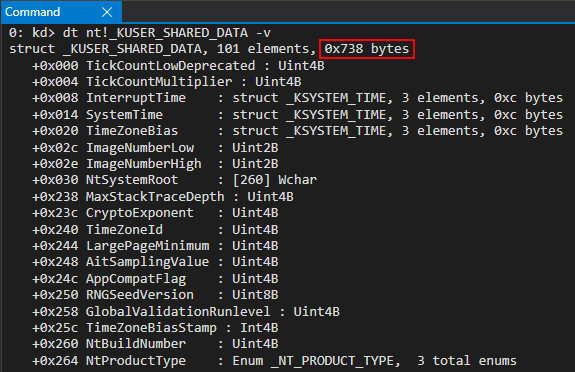
You may recall on Windows that a given memory “page” is 0x1000 bytes in size, or 4KB. Since KUSER_SHARED_DATA is 0x738 bytes in size there are still approximately 0x8C8 bytes of memory available for attackers to abuse. These unused bytes, therefore, still assume the same memory permissions as the rest of KUSER_SHARED_DATA, which is that of RW, or read/write. This means the “KUSER_SHARED_DATA code cave” is a readable and writable code cave which has a static address. Morten Schenk talked about this technique at his BlackHat 2017 talk, and I have also done a previous blog post outlining abusing this structure for code execution.
If this code cave were to be mitigated, an attacker would need to locate another place in memory to place their shellcode. Yes, it is true an adversary with a read/write primitive could corrupt the page table entry (PTE) corresponding to KUSER_SHARED_DATA in order to make the page writable. At this point, however, an adversary would have already needed to bypass kASLR and have a primitive to write to memory - meaning that an attacker already has, essentially, full control of the system. Where mitigation of this code cave comes into play is by making exploitation more arduous by forcing adversaries to prove they have a way to bypass kASLR before writing some nefarious code to memory. If an attacker cannot write directly to a static address, the attacker would therefore need to locate some other memory region. Thus, this would be classified as a smaller, more niche mitigation. In any case, I still found this an interesting topic to research.
Lastly, before beginning, this blog post is presented in context of ntoskrnl.exe and doesn’t translate to the secure kernel in virtual trust level 1 (VTL 1) when Virtualization-Based Security (VBS) is enabled. As Saar Amar pointed out, this structure is actually randomized in VTL 1.
0xfffff78000000000 Is Now Read-Only
My first thought about possible changes to KUSER_SHARED_DATA was that the memory address would finally (somehow) be completely randomized, especially after Saar’s previous tweet. To validate this I simply passed in the static address of KUSER_SHARED_DATA to the dt command in WinDbg and, to my surprise, the structure was still located at 0xfffff78000000000, after it parsing.
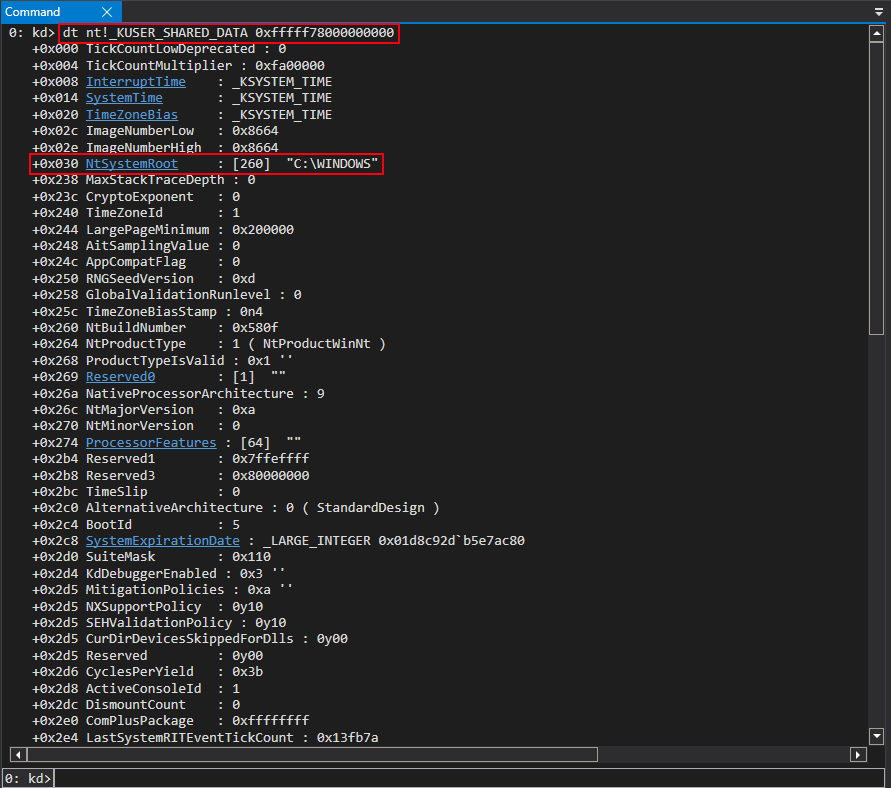
My next thought was to try and write to KUSER_SHARED_DATA, at an offset of 0x800, to look for any unexpected behavior. It was here I realized that KUSER_SHARED_DATA was now read-only, by examining the PTE.
The address provided below, 0xfffffe7bc0000000, is the virtual address of the PTE associated with the virtual address 0xfffff78000000000, or KUSER_SHARED_DATA. You can find the address on your system with the command in Windbg !pte 0xfffff78000000000. I have omitted these commands for readability of this blog, so as to not keep executing this command over and over again. This blog will inform readers what addresses correspond to what and how to find these addresses on your system.

This, at first, made sense. However, after talking with my coworker Yarden Shafir, there are things in KUSER_SHARED_DATA, such as the SystemTime member, which are constantly updated and, therefore, Yarden told me to keep digging, as there obviously was some way KUSER_SHARED_DATA was being written to/updated with a read-only PTE. This also makes sense, as I found out later, because the Dirty bit for the PTE that corresponds with KUSER_SHARED_DATA is set to 0, which means the page hasn’t been written to. So how exactly is this happening?
Armed with the following information, I went to IDA to look for anything interesting.
nt!MmWriteableUserSharedData To The Rescue!
After some searching in IDA for references to either 0xfffff78000000000 or terms like “UserShared”, I stumbled across a symbol I hadn’t seen before - nt!MmWriteableUserSharedData. In IDA, this symbol seems to be defined as 0xfffff78000000000.

However, when looking at a live kernel debugging session, I noticed the address seemed to be different. Not only that, after reboot, this address changed!


We can also see that the static 0xfffff78000000000 address and the new symbol both point to identical memory contents.

However, I was not yet satisfied. Were these two separate pages pointing to two separate structures that just contained identical contents? Or were they somehow intertwined? After viewing both of the PTEs in tandem, I confirmed that both of these virtual addresses, although different, both leveraged the same page frame number (PFN). The PTE for the “static” KUSER_SHARED_DATA and the new symbol nt!MmWriteableSharedUserData can be found with the following commands:
!pte 0xfffff78000000000!pte poi(nt!MmWriteableSharedUserData)
As mentioned, the address of the PTE which corresponds with the “static” KUSER_SHARED_DATA structure is 0xfffffe7bc0000000. The address 0xfffffcc340c47010 is the virtual address which corresponds with the PTE of nt!MmWriteableSharedUserData.
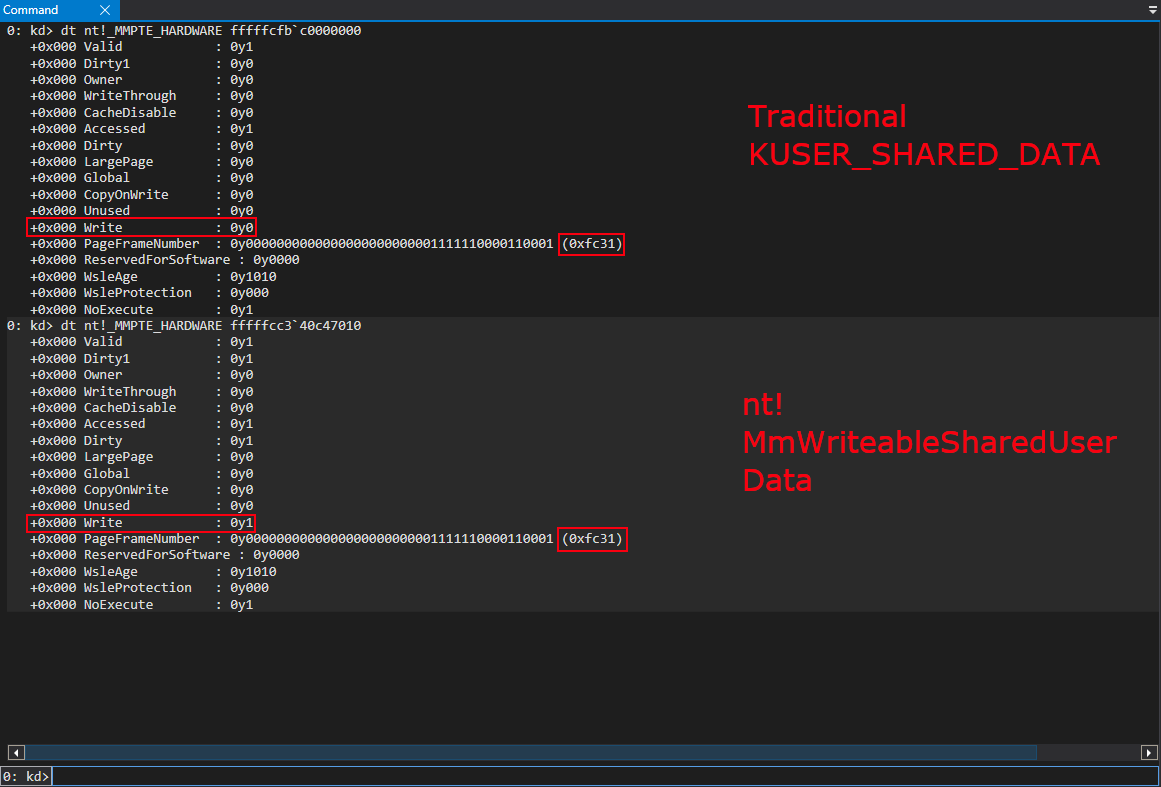
A PFN multiplied by the size of a page (0x1000 generally speaking on Windows) will give you the physical address of the corresponding virtual address (in terms of a PTE, the “final” paging structure used to fetch a 4KB-aligned page). Since both of these virtual addresses contain the same PFN, this means that when converting the PFNs to physical addresses (0xfc1000 in this case), both virtual addresses are backed by the same physical page! We can confirm this by viewing the contents of the physical address backing each virtual address, as well as the virtual addresses themselves.

What we have here are two virtual addresses, with different memory permissions (one is read-only and the other is read/write) backed by one physical page. In other words, there are two virtual addresses with different views of the same physical memory. How is this possible?
tl;dr - Memory Sections
The main “gist” of the changes implemented surrounding KUSER_SHARED_DATA is the concept of memory sections. What this means is that a section of memory can essentially be shared by two processes (this is true for the kernel, as is in our case). The way this works is that the same physical memory can be mapped to a range of virtual addresses.
In this case, the new randomized read/write view of KUSER_SHARED_DATA, nt!MmWriteableUserSharedData (a virtual address) is backed by the same physical memory as the “static” KUSER_SHARED_DATA (another virtual address). This means that now there are two “views” of this structure, as seen below
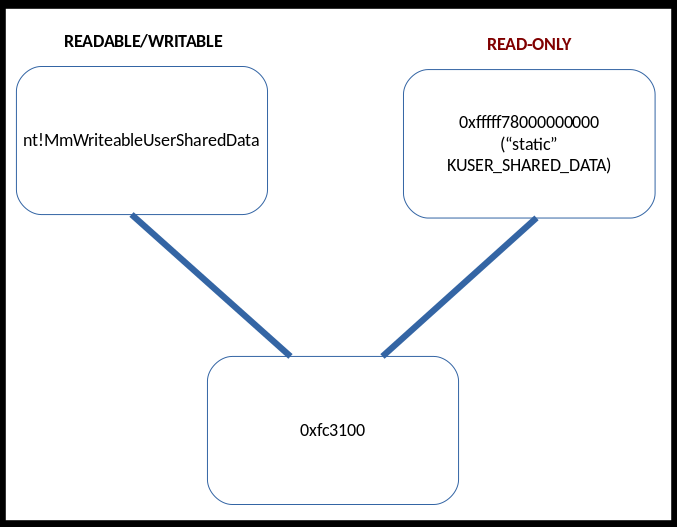
This means that updating one of the virtual addresses (e.g. nt!MmWriteableSharedUserData) will update the other virtual address (0xfffff78000000000). This is because making a change to one of the virtual addresses will update the physical memory contents. Since the physical memory contents back both virtual addresses, both virtual addresses will receive updates. This provides a method for Windows to keep the old KUSER_SHARED_DATA address, while also allowing a new mapped view that is randomized, to “mitigate” the static read/write code cave traditionally found in KUSER_SHARED_DATA. The “old” address of 0xfffff78000000000 can now be marked as read-only, as there is a new view of this memory which can be used in its place, which is randomized!
If you were looking for a quick blog to talk about the changes made, that is perfectly okay and I will preface the remainder of this blog by saying that you may stop here if you were looking for a quick rundown of the higher-level details. The rest of this blog will outline the more intricate, lower-level details of the implementation.
If you are interested in how this looks at a bit of a deeper level, in terms of how Windows actually manifested these new updates, like myself, please feel free to read the rest of this blog post! I learned a great amount of technical details in terms of lower-level memory paging concepts, and just wanted to share these thoughts with anyone reading (should anyone care).
nt!MiProtectSharedUserPage
Before continuing with the analysis, permit me to introduce two terms. When I refer to the memory address 0xfffff78000000000, the static mapping of KUSER_SHARED_DATA, I will use the term “static” KUSER_SHARED_DATA from here on out. When I refer to the new “randomized mapping”, I will simply use the symbol name of nt!MmWriteableSharedUserData. This will allow me to delineate each time which “version” I am talking about.
After some dynamic analysis in WinDbg, I discovered the answer to my previous question about how these changes to KUSER_SHARED_DATA were implemented. I first started by setting a breakpoint on ntoskrnl.exe being loaded. It’s possible to do this, in an existing kernel debugging session, with the following commands:
sxe ld nt.reboot
After the breakpoint is hit, we can actually see that the newly-found symbol nt!MmWriteableUserSharedData points to the “static” KUSER_SHARED_DATA address.
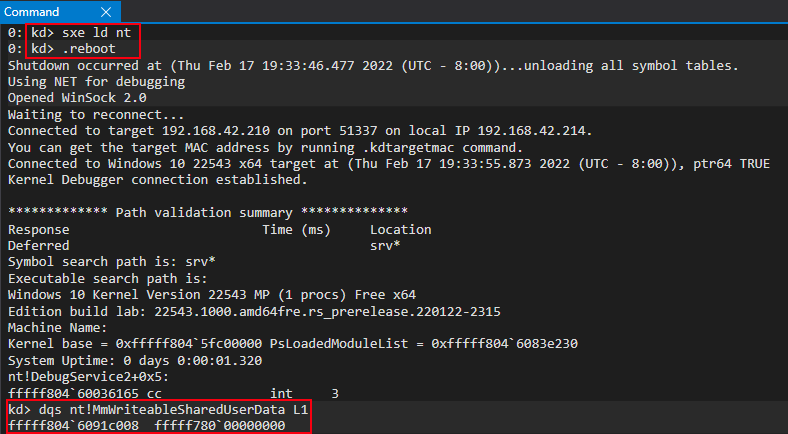
This is obviously indicative that this symbol is updated further along in the loading process.
While performing some reverse engineering to identify how this happens, I noticed an interesting cross reference to nt!MmWriteableSharedUserData in the function nt!MiProtectSharedUserPage via IDA.
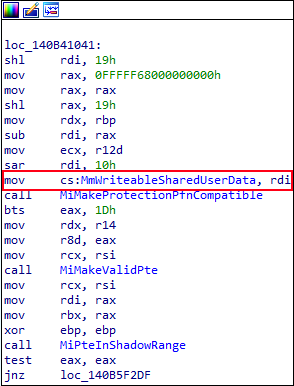
While execution was still paused, as a result of the ntoskrnl.exe breakpoint, I set another breakpoint on the aforesaid function nt!MiProtectSharedUserPage and confirmed, after reaching the new breakpoint, the nt!MmWriteableSharedUserData symbol still pointed to the old 0xfffff78000000000 address.
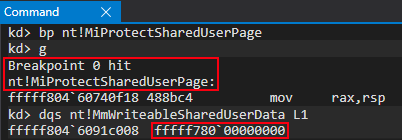
Even more interesting, the “static” KUSER_SHARED_DATA’ is still static, readable, and writable at this point in the loading process! The below PTE address of 0xffffb7fbc0000000 is the virtual address of the PTE associated with the virtual address of 0xfffff78000000000. The PTE address has changed due to us rebooting the system as a result of the break-on-load of ntoskrnl.exe. As mentioned, this address can always be found on your system with the command !pte 0xfffff78000000000.
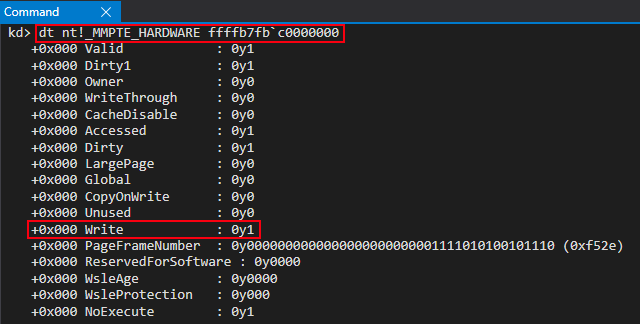
Since we know 0xfffff78000000000, the address of the “static” KUSER_SHARED_DATA structure, becomes read-only at some point, this is indicative of this function likely being responsible for changing the permissions of this address AND also dynamically filling nt!MmWriteableSharedUserData, especially based on naming convention.
Looking deeper into the disassembly of nt!MiProtectSharedUserPage we can see that the symbol nt!MmWriteableSharedUserData is updated with the value in RDI at the time that this instruction executes. But where does this value come from?

Let’s take a look at the beginning of the function. The first thing that stands out is the kernel-mode address and calls to nt!MI_READ_PTE_LOCK_FREE and nt!Feature_KernelSharedUserDataAaslr__private_IsEnabled (which isn’t very interesting for our purposes).
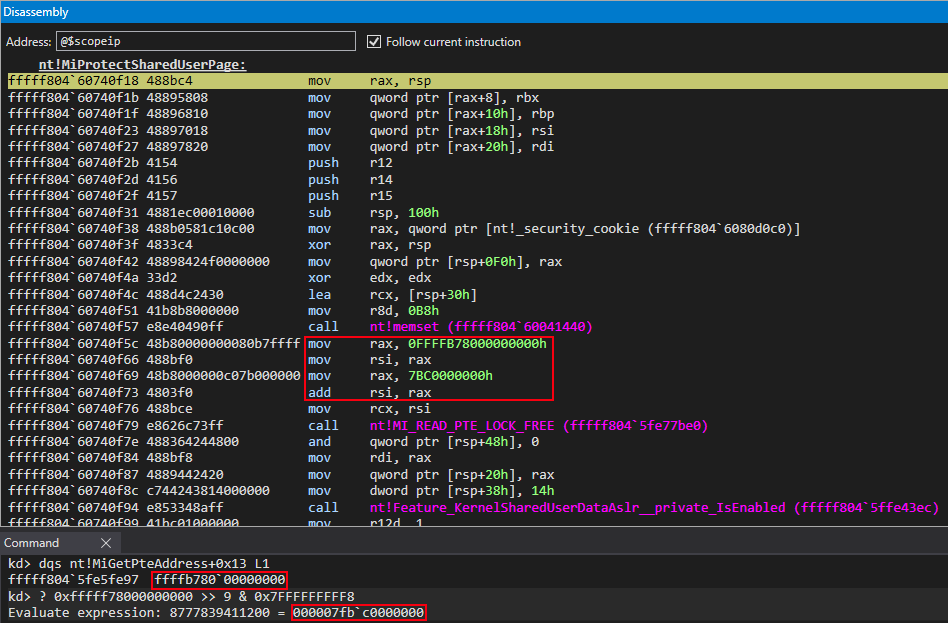
The kernel-mode address in the image above of 0xfffffb7000000000, outlined in a red box in the Disassembly window of WinDbg , is actually the base of the page table entries (e.g. the address of the PTE array). The second value, the constant of 0x7bc00000000, is the value used to index this PTE array to fetch the PTE associated with the “static” KUSER_SHARED_DATA. This value (the index into the PTE array) can be found with the following formula:
- Converting the target virtual address (in this case,
0xfffff78000000000) into a virtual page number (VPN) by dividing the address by the size of a page (0x1000in this case) - Multiply the VPN by the size of a PTE (64-bit system = 8 bytes)
We can see this by replicating this formula on the virtual address of 0xfffff78000000000. The resulting value will be the appropriate index into the PTE array to get the PTE associated with the “static” KUSER_SHARED_DATA. This can be seen in the Command window of WinDbg above.
This means the PTE associated with the “static” KUSER_SHARED_DATA is going to be passed in to nt!MI_READ_PTE_LOCK_FREE. The address of said PTE is 0xffffb7fbc0000000.
nt!MI_READ_PTE_LOCK_FREE, at a high level, will dereference the contents of the PTE and return them, while also performing a check on the in-scope page table entry to see if it is within the known address space of the PML4E array, which contains an array of PML4 page table entries for usage with the PML4 paging structure. Recall that the PML4 structure is the base paging structure. So, in other words, this ensures that the page table entry provided resides somewhere within the paging structures. This can be seen below.
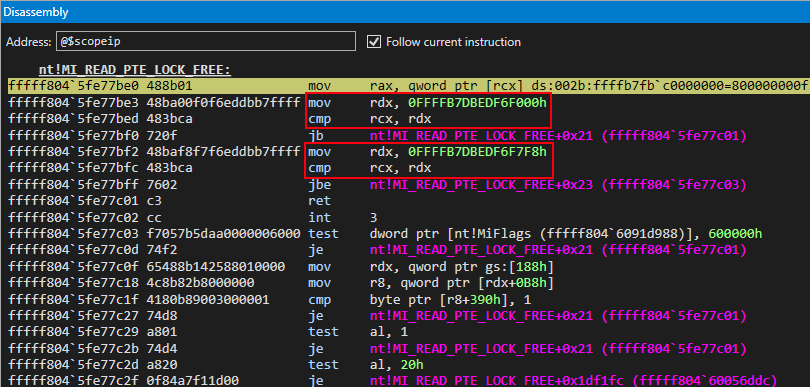
However, slightly more nuanced, the function is actually checking to see if the page table entry resides within the “user mode paging structures”, known otherwise as the “shadow space”. Recall that with KVA Shadow’s implementation, Microsoft’s implementation of Kernel Page-Table Isolation (KPTI), there are now two sets of paging structures: one for kernel mode execution and one for user mode. This mitigation was used to mitigate Meltdown. This check is easily “bypassed”, as the PTE is obviously mapped to a kernel mode address and, thus, not represented by the “user mode paging structures”.
nt!MI_READ_PTE_LOCK_FREE then returns the dereferenced contents of the PTE (e.g. the PTE “bits”) if the PTE doesn’t reside within the “shadow space”. If the PTE does reside in the “shadow space”, there are a few more checks performed on the PTE to determine if KVAS is enabled before the contents are returned. This is not too important for the overall changes we are focusing on, from an exploitation perspective, but still a part of the overall “process”.
Additionally, nt!Feature_KernelSharedUserDataAslr__private_IsEnabled isn’t very useful to us, except for letting us know we are potentially on the right track by the naming convention. This function mainly seems to be for metrics and telemetry gathering about this feature.
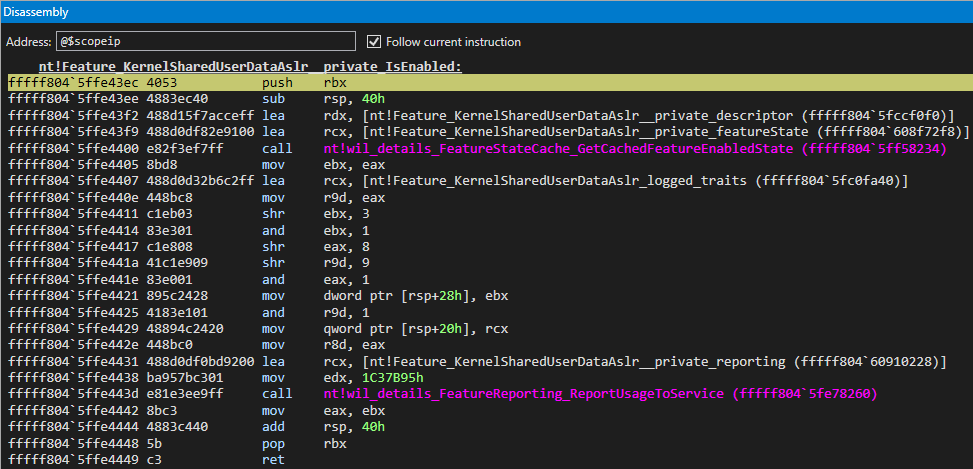
Earlier, after the first call to nt!MI_READ_PTE_LOCK_FREE, the contents of the PTE for the “static” KUSER_SHARED_DATA were copied to a stack address - RSP at an offset of 0x20. This stack address, very similarly, is used in another call to nt!MI_READ_PTE_LOCK_FREE. This, again, isn’t particularly important to us - but it is part of the process.
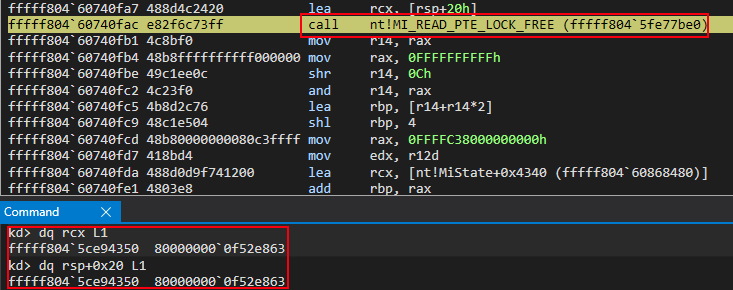
More interestingly, however, is the fact that nt!MI_READ_PTE_LOCK_FREE dereferences the PTE contents and returns them via RAX. Since the PTE “bits” for the “static” KUSER_SHARED_DATA, which define the memory properties/permissions, are in RAX, they’re then acted upon in the subsequent bitwise-operations to extract the page frame number (PFN) from the PTE of the “static” KUSER_SHARED_DATA. This value is 0xf52e within the PTE, which has a value of 0x800000000000f52e863.
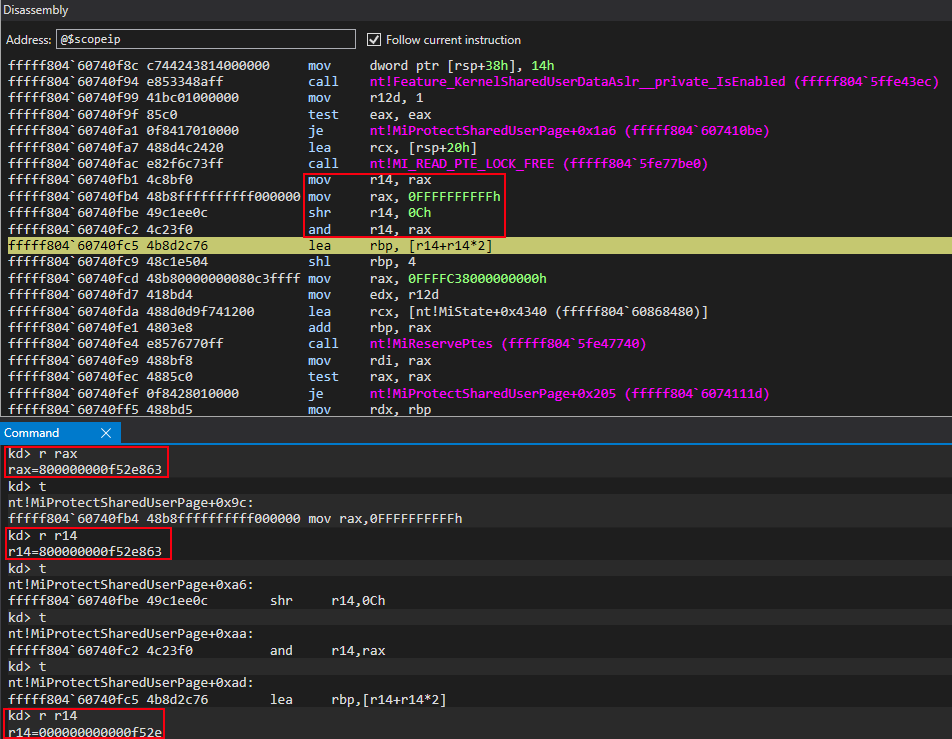
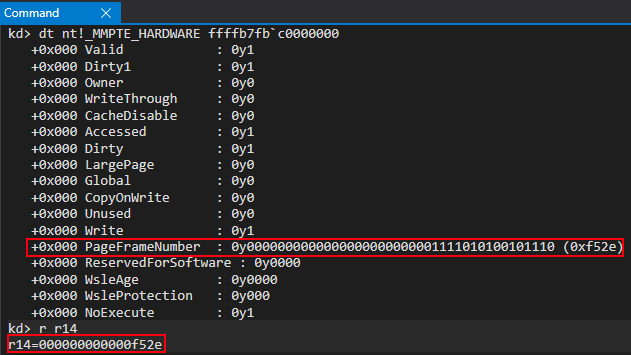
This PFN will be leveraged later on in a call to nt!MiMakeValidPte. For now, let’s move on.
We can now turn our attention to see that a call to nt!MiReservePtes is about to occur.

Please permit me to quickly provide a brief word on PFN records. A PFN “value” is technically just an abstract value that, when multiplied by 0x1000 (the size of a page), gives us a physical memory address. This is typically either the address of the next paging structure during the memory paging process, or it is used to fetch a final 4KB-aligned physical memory page if being leveraged by the “last” paging table, the PT (page table).
In addition to this, PFN records are also stored in an array of virtual addresses. This array is known as the PFN database. The reason for this is that the memory manager accesses page table entries via linear (virtual) addresses, which increases performance as the MMU does not need to walk all of the paging structures constantly to fetch PFNs, page table entries, etc. This provides an easy way for the records to just be referenced via an index into an array. This goes for all “arrays”, including the PTE array. A function such as nt!MiGetPteAddress performs an index into the corresponding page table array, such as the PTE array (for nt!MiGetPteAddress, PDE array (PDPT entries, done via nt!MiGetPdeAddress), etc.
Knowing this, we can see prior to the call to nt!MiReservePtes that the appropriate index into the PFN database that corresponds to the “static” KUSER_SHARED_DATA is calculated. This essentially means we are retrieving the virtual address of said PFN record (a MMPFN structure) from the PFN database.
We can see this as the base of the PFN database, 0xffffc38000000000 in this case, is involved in the operation. The final virtual address of 0xffffc380002df8a0 (the virtual address of the PFN record associated with the “static” KUSER_SHARED_DATA) can be seen below in RBP. It will eventually be used as the second argument in a future function call to nt!MiMakeProtectionPfnCompatible.
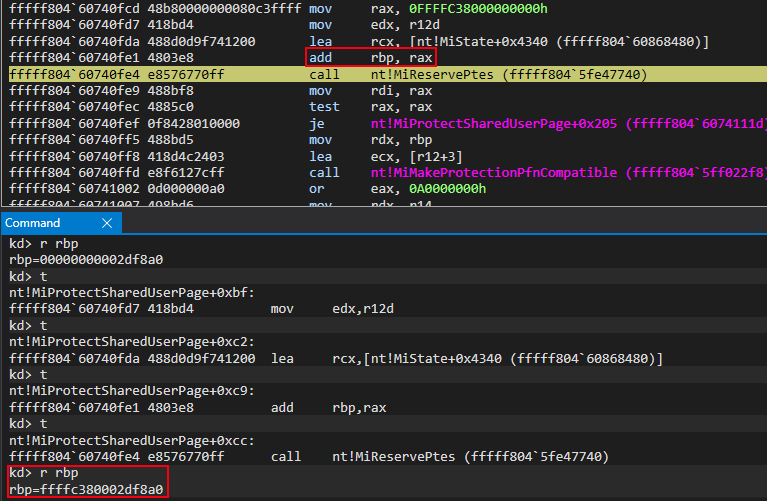
We can corroborate this by parsing the above virtual address as a MMPFN structure to see if the PteAddress member corresponds to the known PTE of the “static” KUSER_SHARED_DATA. As we know, the PTE is located at 0xffffb7fbc0000000.

The PteAddress member of the PFN structure aligns with the virtual address of the PTE associated with the “static” KUSER_SHARED_DATA - thus confirming this is the associated PFN record with the “static” KUSER_SHARED_DATA.
This value is then used in a call to nt!MiReservePtes, which we can see from two images ago. We know the first argument for this function will go into the RCX register, per the __fastcall calling convention. This argument is actually a nt!_MI_SYSTEM_PTE_TYPE structure.
According to CodeMachine, when a call to nt!MiReservePtes occurs, this structure is used to define what kind of allocation will occur in order to reserve memory for the PTE being created. Allocations, when requested with nt!MiReservePtes, may be suggestive of a request to allocate a piece of virtual memory from the System PTE region. The System PTE region is used for mapped views of memory, memory descriptor lists (MDLs), and other items. This information, in combination of our searching for an answer as to how two virtual addresses are backed by the same physical page, is very indicative of different “views” of memory being used (e.g. two virtual addresses correspond to one physical address so both virtual addresses contain the same contents but may have different permissions). Additionally, we can confirm that this allocation is coming from the System PTE region, as the VaType member of the nt!_MI_SYSTEM_PTE_TYPE structure is set to 9, which is a value in an enumeration that corresponds to MiVaSystemPtes. This means the allocation, in this case, will come from the System PTE memory region.
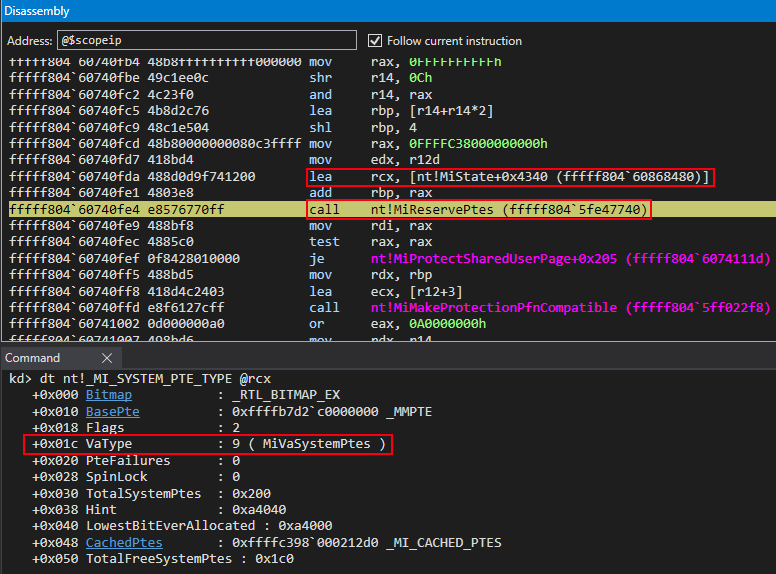
As we can see after the call occurs, the return value is a kernel-mode address within the same address space of the System PTE region, as defined by the BasePte member.

At this point, the OS has essentially allocated memory from the System PTE region, which is commonly used for mapping multiple views of memory, in the form of an unfilled PTE structure. The next step will be to properly configure this PTE and assign it to a memory address.
Said process continues with a call to nt!MiMakeProtectionPfnCompatible. As previously mentioned, the second argument for this function will be the virtual address of the PFN record, from the PFN database, associated with the PTE that is applied to the “static” KUSER_SHARED_DATA.
The first argument passed to nt!MiMakeProtectionPfnCompatible is a constant of 4 (which can be seen 4 screenshots below in the Command window of WinDbg). Where does this value come from? Taking a look at ReactOS we can see two constants that are outlined for memory permissions enforced by PTEs.

According to ReactOS, there is also a function called MI_MAKE_HARDWARE_PTE_KERNEL, which leverages these constants. The prototype and definition can be seen below.
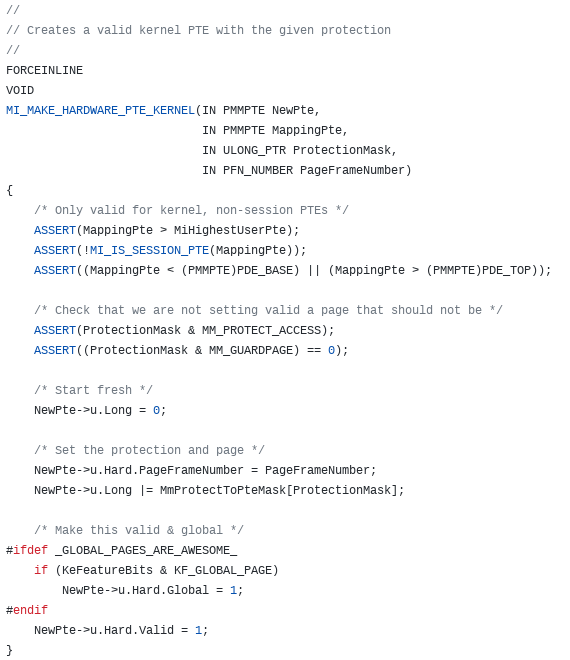
This function provides a combination of the functionality exposed by both nt!MiMakeProtectionPfnCompatible and nt!MiMakeValidPte (which is a function we will see shortly). The value 4, or MM_READWRITE, is actually an index into an array called MmProtectToPteMask. This array is responsible for converting the requested permission of the page (4, or MM_READWRITE) to a PTE-compliant mask.
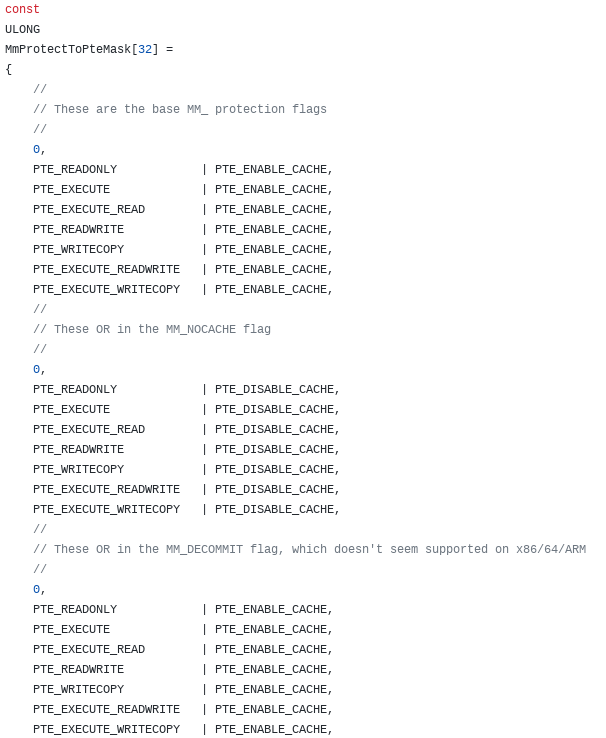
We can see the first five elements are as follows: {0, PTE_READONLY, PTE_EXECUTE, PTE_EXECUTE_READ, PTE_READWRITE}. From here we can confirm that indexing this array at the index of 4 will retrieve a PTE mask of PTE_READWRITE, which are exactly the memory permissions we would like nt!MmWriteableSharedUserData to assume, as we know this should be the “new mapped view” of KUSER_SHARED_DATA, which is writable. Recall also that the virtual address of the PFN record associated with the “static” KUSER_SHARED_DATA is used in the function call, via RDX.
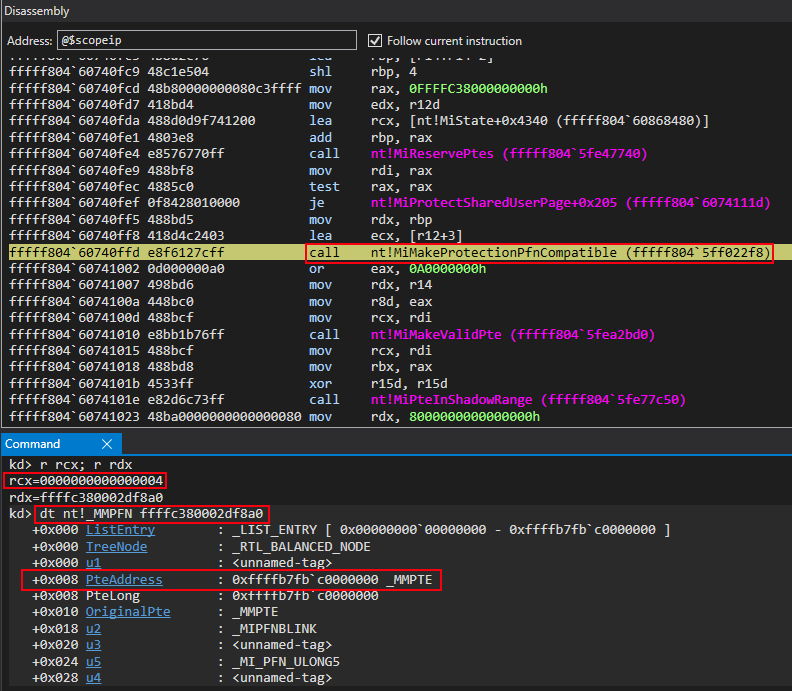
After the function call, the return value is a “PTE-compatible” mask that represents a readable and writable page.
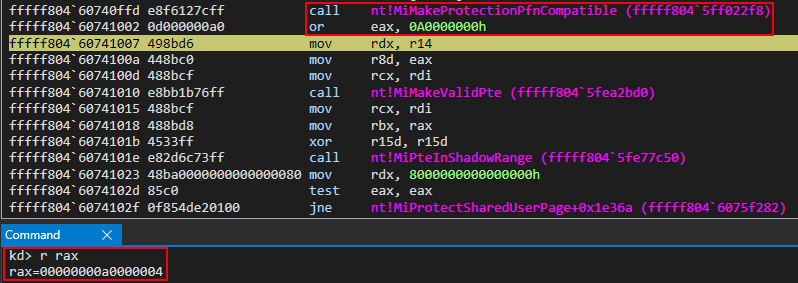
At this point we have:
- An address for our PTE, which is currently empty
- A “skeleton” for our PTE (e.g. a readable/writable mask to be supplied)
With this in the back of our mind, let’s now turn our attention to the call to nt!MiMakeValidPte.
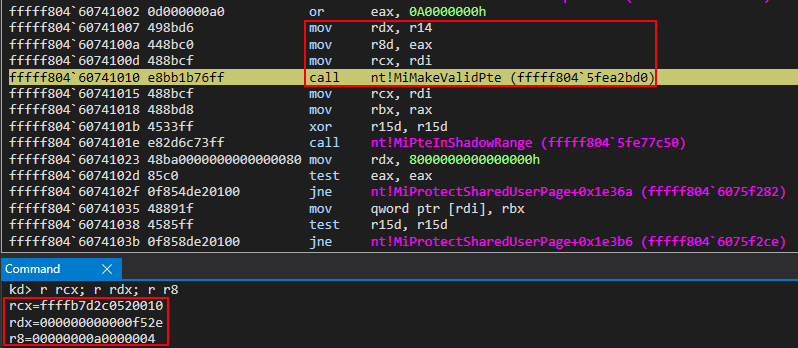
nt!MiMakeValidPte essentially provides “the rest” of the functionality outlined by the ReactOS function MI_MAKE_HARDWARE_PTE_KERNEL. nt!MiMakeValiePte requires the following information:
- Address of the newly created, empty PTE (this PTE will be applied to the virtual address of
nt!MmWriteableUserSharedData). This is currently in RCX - A PFN. This is currently in RDX (e.g. not the virtual address from the PFN database, but the raw PFN “value”)
- A “PTE-compliant” mask (e.g. our read/write attributes). This is currently in R8
All of this information can be seen above in the previous screenshot.
In terms of “mapping different views of the same physical memory”, the most important component here is the value in RDX, which is the actual PFN value of KUSER_SHARED_DATA (the raw value, not the virtual address). Let’s recall first that a PFN, at a high level, is essentially a physical address, when multiplied by the size of a page (0x1000 bytes, or 4KB). This is true, especially in our case, as we are dealing with the most granular type of memory - a 4KB-aligned piece of memory. There are no more paging structures to index, which is usually what a PFN is used for. This means the PFN, in this case, is used to fetch a final, 4KB-aligned memory page.
We know that the function we are executing inside of (nt!MiProtectSharedUserPage) creates a PTE (via nt!MiReservePtes and nt!MiMakeValidPte). As we know, this PTE will be applied to a virtual address and used to map said virtual address to a physical page, essentially through the PFN associated with the PTE. Currently, the PFN that will be used for this mapping is stored in RDX. At a lower level, this value in RDX multiplied by the size of a page (4KB) will be the actual physical page the virtual address is mapped to.
Interestingly enough, this value in RDX, which was previously preserved after the second call to nt!MI_READ_PTE_LOCK_FREE, is the PFN associated with KUSER_SHARED_DATA! In other words, the virtual address we assign this newly created PTE to (which should eventually be nt!MmWriteableUserSharedData) will be backed by KUSER_SHARED_DATA’s physical memory and, thus, when updates are made to the contents of nt!MmWriteableUserSharedData the physical memory backing it will also be updated. Since the “static” KUSER_SHARED_DATA (0xfffff78000000000) is also backed by THE SAME physical memory it also will receive the updates. Essentially, even though the read-only “static” KUSER_SHARED_DATA can’t be written to it will still receive updates made by nt!MmWriteableUserSharedData, which is readable and writable. This is because both virtual addresses are backed by the same physical memory. Whatever happens to one of these will happen to the other!
Knowing this means that there is no good reason to have the “normal” (e.g. 0xfffff78000000000) KUSER_SHARED_DATA structure address be anything other than read-only, as there is now another memory address that can be used in its place. The benefit here is that the writable “version” or “mapping”, nt!MmWriteableUserSharedData, is randomized!
Moving on now, we are telling the OS we want a valid PTE that is readable and writable, backed by KUSER_SHARED_DATA’s PFN (physical address for all intents and purposes), and will be written to the PTE we have already allocated from the System PTE region (since this memory is being used for mapping “views”).
After executing the function, we can see this is the case!
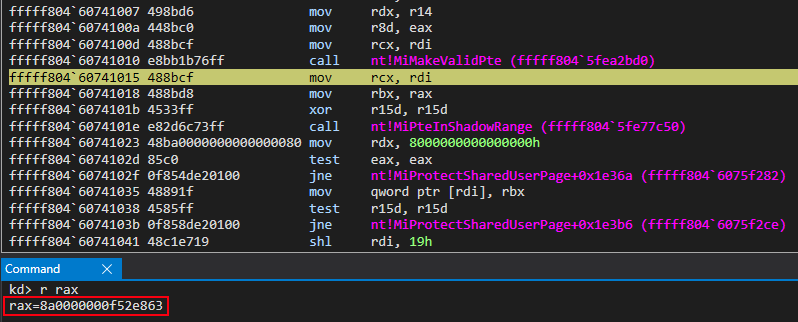
The next function call, nt!MiPteInShadowRange, essentially just does bounds checking to see if our PTE resides in the shadow space. Recall earlier that with the implementation of Kernel Virtual Address Shadow (KVAS) that paging structures are separated: one set for user mode and one set for kernel mode. The “shadow space”, otherwise known as the structures used for user mode addressing, are within the range checked by nt!MiPteInShadowRange. Since we are dealing with a kernel mode page, obviously the PTE it is applied to is not within the “shadow space”. It is not really of interest to us for our purposes.
After this function call, a mov qword ptr [rdi], rbx instruction occurs. This updates our allocated PTE, which is still blank, with the proper bits created from our call to nt!MiMakeValidPte! We now have a valid PTE, backed by the same physical memory as KUSER_SHARED_DATA located at the virtual address of 0xfffff78000000000!

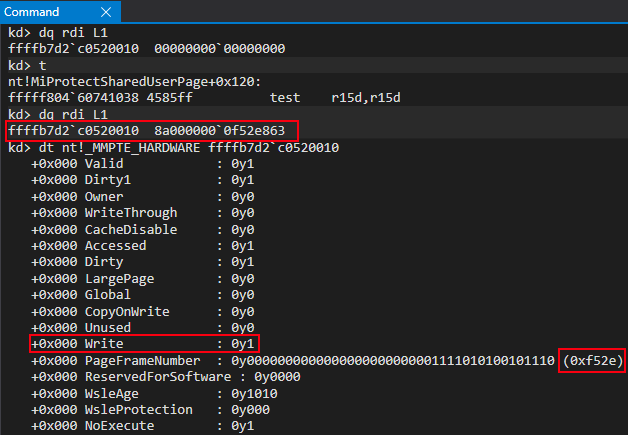
At this point, we are just a few instructions away from our target symbol of nt!MmWriteableUserSharedData being updated with the new ASLR’d mapped view of KUSER_SHARED_DATA. Then the “static” KUSER_SHARED_DATA can be made read-only (recall it is still read/write at this point in the loading process!).

Currently, in RDI, we have the address of the PTE we want to use for our new read/write and randomized mapped view of KUSER_SHARED_DATA (generated via nt!MiReservePtes). The above screenshot shows that there will be some bitwise operations performed on RDI and, as well, we can see that the base of the page table entries will be involved with this operation. These are simply compiler optimizations for converting a given PTE to the virtual address the PTE is applied to.
This is a necessary step, recall, as up until this point we have successfully generated a PTE from the System PTE region and have marked it as read/write, told it to use the “static” KUSER_SHARED_DATA as the physical memory backing the virtual memory, but we have not actually applied it to the virtual memory address which will be described and mapped by this PTE! This virtual address we want to apply this PTE to will be the value we want to store in nt!MmWriteableUserSharedData!
Let’s again recall the bitwise operations that are in place which will convert the new PTE to the virtual address it backs.

As we know, we have the target PTE in the RDI register. We know the steps to retrieve the PTE associated with a given virtual address are as follows, which indexes the PTE array appropriately:
- Convert the virtual address to a virtual page number (VPN) by dividing the virtual address by the size of a page (
0x1000bytes on a standard Window system) - Multiply the above value with the size of a PTE (
0x8bytes on 64-bit system) - Add the value to the base of the page table entry array
This corresponds to indexing the PTE array as follows: PteBaseArray[VPN]. Since we know how to go from a virtual address to a PTE, we should be able to reverse these steps to retrieve the virtual address associated with a given PTE.
With PTE in hand, the “reversed” process is as follows:
- Subtract the PTE array base address from the PTE sitting in RDI (our target PTE) to extract the index into the PTE array
- Divide the value by the size of a PTE (
0x8bytes) to retrieve the virtual page number (VPN) - Multiply this value by the size of a page (
0x1000) to retrieve the virtual address
We also know that the compiler generates a sar rdi, 10h instruction which will sign extend the value generated from the above steps. If we replicate this process within WinDbg we can see our final value (0x0000a580a4002000) would be converted to the address 0xffffa580a4002000.

Comparing our computed value with the kernel-produced value, we can see we now have the corresponding virtual address to our PTE, which now is backed by the same physical memory as KUSER_SHARED_DATA and both addresses match up to 0xffffa580a4002000! We can conclude the bitwise operations are part of some macro which converts PTEs to virtual addresses, and this is compiler-optimized code to do so!

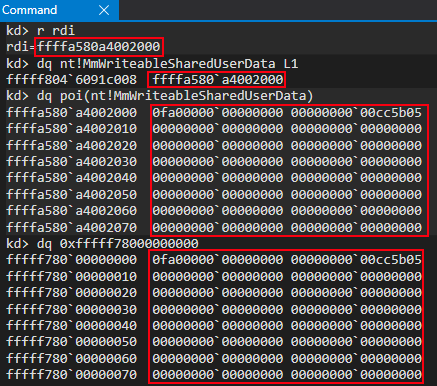
This functionality is provided in ReactOS in the form of a function called MI_WRITE_VALID_PTE. As we can see it essentially not only writes the PTE contents to the PTE address (in this case the allocation from the System PTE region via nt!MiReservePtes) but it also fetches the virtual address associated with the PTE through the function MiPteToAddress.
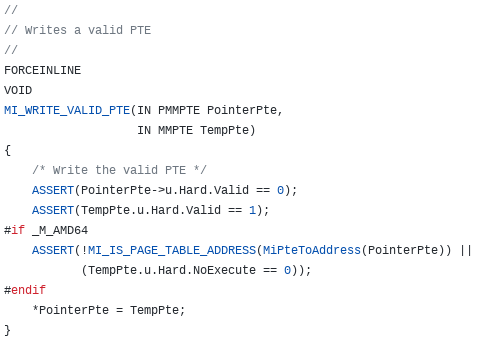
Great! However, there is one last thing we need to do and that is convert the “static” KUSER_SHARED_DATA address to read-only. We can already see we are queued up for a call to nt!MiMakeProtectionPfnCompatible. In RCX, where the memory permission constant is, we can see a value of 1, or MM_READONLY if we recall earlier from when we created a PTE-compliant mask for the read/write mapping of KUSER_SHARED_DATA. In other words, the only memory “permissions’’ afforded to this page will be read.
RDX, which contains our index into the PFN array, shows we have the PFN associated with the “static” KUSER_SHARED_DATA by comparing the virtual address of the PTE for the “static” KUSER_SHARED_DATA (PTE located at 0xffffb7fbc0000000) to the PTE located in the PFN structure, MMPFN. This gives us a PTE-compliant value.
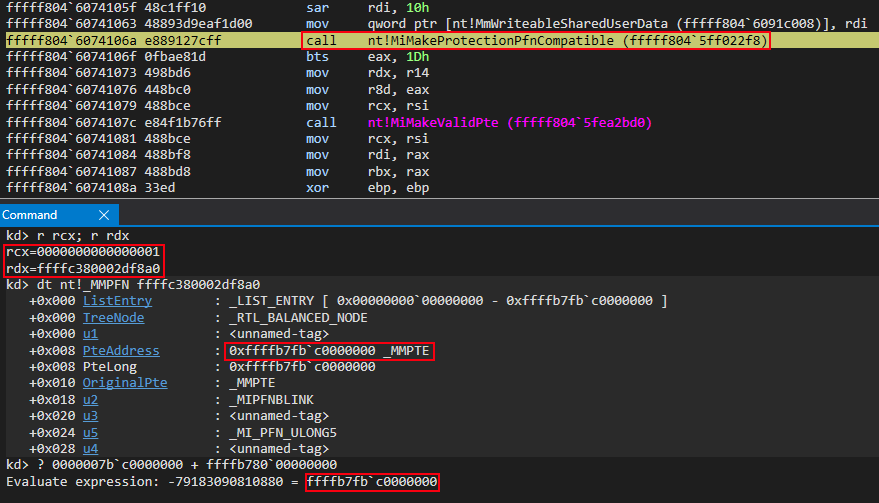

Identically to last time, now just with a read-only page, we setup a call to nt!MiMakeValidPte to assign to the “static” KUSER_SHARED_DATA read-only permissions, through the virtual address of its PTE (0xffffb7c000000000).
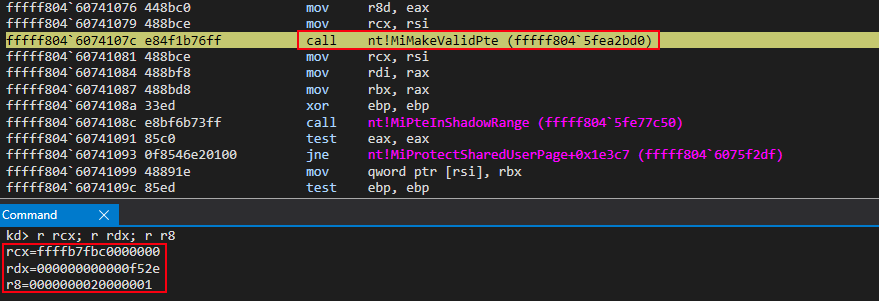
After the call succeeds, a PTE has been generated for use with pages intended to be read-only.

The “static” KUSER_SHARED_DATA gets updated through the same methods aforementioned (the method provided in ReactOS called MI_WRITE_VALID_PTE).
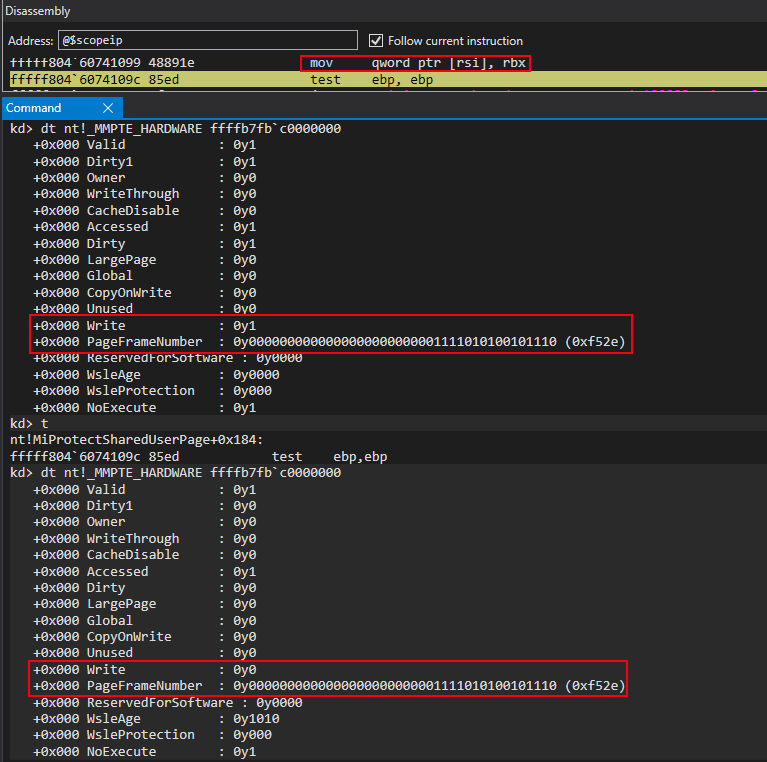
For our purposes, this is the end of the interesting things that nt!MiProtectSharedUserPage does! We now have two virtual addresses that are backed by KUSER_SHARED_DATA’s physical memory (one read-only, the “static” 0xfffff78000000000 KUSER_SHARED_DATA structure and a new nt!MmWriteableUserSharedData version which is randomized and read/write)!
We can now see in IDA, for instance, when KUSER_SHARED_DATA needs to be updated, this is done through the new symbol which is randomized and writable. The below image is taken from nt!KiUpdateTime, where we can see several offsets of KUSER_SHARED_DATA are updated (namely 0x328 and 0x320). On the same note, in the same photo, we can see that when members from KUSER_SHARED_DATA are read, Windows goes through the old “static” hard coded address (in this case, 0xfffff78000000008 and 0xfffff78000000320 in the IDA screenshot).
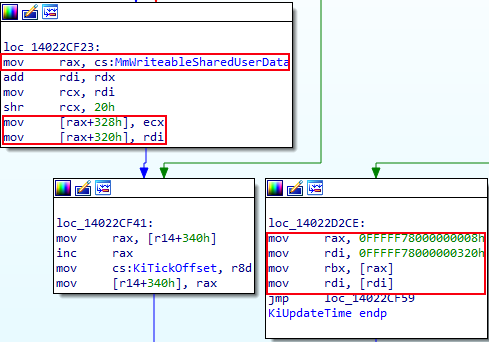
Exploitability Going Forward and Conclusion
Obviously, the same primitive of abusing this code cave no longer will exist, and one of the last (if not the last) static structure has now been mitigated, which attackers have abused in the past. However, with exploitation today, a kASLR bypass is surely needed to gain code execution. This is a smaller mitigation which forces an adversary to prove they can at least bypass kASLR fully in order to write code somewhere reliably. It goes without saying that it would be possible to “bypass” (better word is circumvent, versus “bypassing” the underlying feature), if you write to memory early enough in the kernel loading process via a race condition or some other primitive, to write your code to the static 0xfffff78000000000+0x800 KUSER_SHARED_DATA code cave, as we know this structure is still readable and writable when the kernel is first mapped into memory. However, when the kernel fully loads, this region will be read-only. But, nonetheless, it is still possible, due to the initialization happening during the kernel loading. There are public exploits which make use of this primitive, namely my friend and peer chompie1337’s SMBGhost proof-of-concept, so it was definitely worthwhile to pursue to not only raise the bar for attackers, but to break public exploits in their current state. This is a pretty niche change/mitigation, but I thought it nonetheless would be fun to blog about and I learned quite a bit about the System PTE region and memory views along the way.
As always feel free to please reach out with comments, questions, corrections, or suggestions!
Peace, love, and positivity :-)